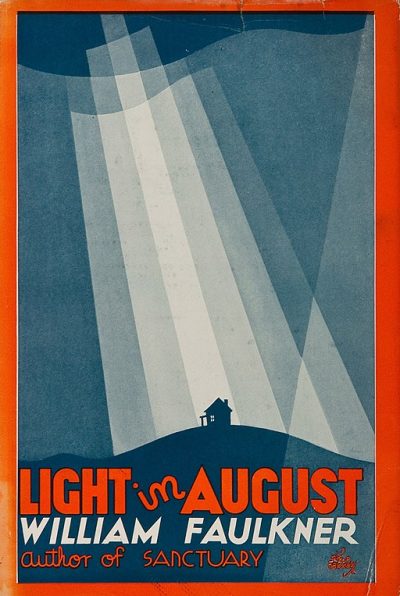…but is it a crime novel?
William Faulkner’s Light in August isn’t a traditional mystery in any sense, but it certainly is a crime novel. It’s the story of Joanna Burden’s death – a middle-aged single woman living alone on the edge of town – and Joe Christmas, the reclusive bootlegger accused of her murder. It’s also the story of a trio of social outcasts who find themselves sucked into the hunt for Christmas: Lena Grove, searching for the father of her soon-to-be-born baby; Byron Bunch, a solitary sawmill worker who befriends Lena; and Bunch’s one friend Gail Hightower, an elderly, disgraced ex-minister. Set in 1930s northern Mississippi, the small town of Jackson (the town Faulkner invented for all his stories) itself becomes an important character, as the rumors and fears spread faster than fire through a clapboard house.
The actions and reactions of the townsfolk frame what is arguably the book’s most compelling aspect, its exploration of Christmas’s backstory and psyche, his socialization to manhood through his troubled upbringing, and his complicated racialization as an orphan raised White but who believes himself to have a Black parent. The mysteries – Who killed Joanna Burden? Is Joe Christmas “really” Black? — drive a storyline that centers less on providing answers than digging into how and why people believe what they do, about themselves and about others. Light in August is ultimately the story of a man hounded by his history and a town that can’t not believe the worst about him.
Faulkner did write some traditional mysteries (mostly short stories), where his detective figure, the lawyer Gavin Stevens, uses his legal acumen and knowledge of everyday life in rural Mississippi to resolve crimes. We know from his library that Faulkner was a reader of both hard-boiled and Golden Age mysteries; he worked in Hollywood on crime films occasionally; and he was drinking buddies with Dashiell Hammett for a while. Faulkner certainly knew his way around detective stories, and he uses that knowledge in Light in August to tease his readers. There’s material evidence and a crime scene, eye witness accounts of finding bodies and escaping perpetrators, weapons that appear and disappear, and a fantastically frustrating sniffer dog chase through the Mississippi countryside. But these detective story trappings never add up to a “whodunnit” resolution.
Light in August is one of Faulkner’s major literary achievements, which makes it both richly compelling and at times challenging to read. Those challenges lie in Faulkner’s prose style and temporal shiftiness (be sure to get an edition with the timeline in the back!) as well as its content. Both Burden and Christmas experience traumatic events and, as you might expect of a book published in 1932, the racial slurs are non-stop. If you’re looking to pick up some Faulkner mystery stories with a lower bar to entry, his short story collection Knight’s Gambit is where to go. Still, if you like digging into the mindset of both “bad guys” and their accusers, Light in August repays the effort. When I first picked it up, I read it like you might eat a Condor chocolate – slowly, savoring every chapter, attuned to the subtle flavors of Faulkner’s prose, wowed by the artistry and detail. And yes, I may have lost all of one evening to the question of Civil War pistol firing mechanisms. (Did it matter to the plot? Ah, that would be telling.) Most of the class was surprised by how much they liked the novel, so it’s clearly not just me.
Professor rating: 4 stars
Spring 2024 class rating: 3.3 stars
(Image of the cover of the first edition, because look at that graphic design!)

